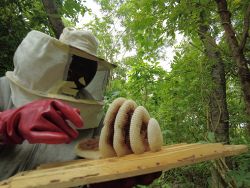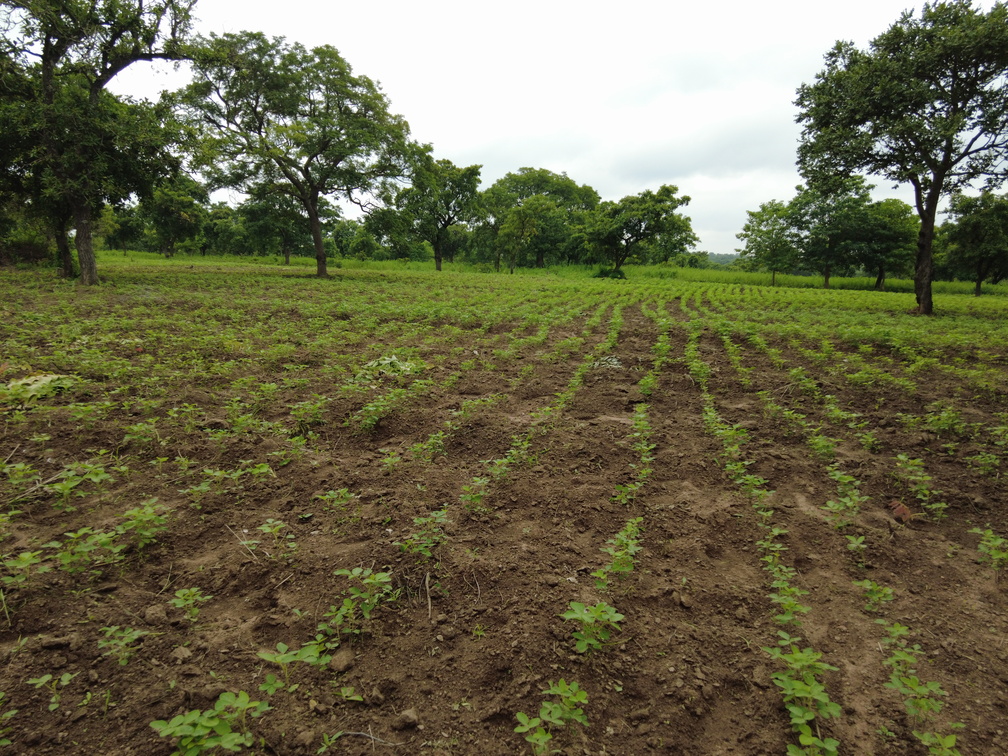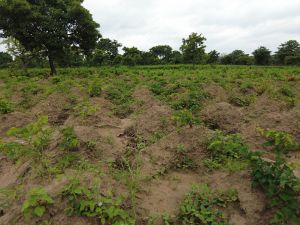Cabinet Monrado's experimental farm
Agroecology, diversity of crops, soil fertility, compost, crop associations
Fadel Sacca Gounou




The Monrado firm has created an experimental farm in Benin and manages its land and livestock according to agroecological principles. Currently, their research and training themes mainly focus on the restoration of cover crops and regaining soil fertility. Here is a portrait of their farm.
Context
The farm
- Farm name: Experimental farm of Monrado firm.
- Location: Ndali (64 km north of Parakou), Benin.
- Installation date: 2021.
- Cultivated area: 16 ha.
- Soil texture: Sandy-loam.
- Number of people working on the farm:
- 2 full-time workers.
- 6 to 7 occasional workers paid by task: plowing, maintenance of the apiary. They work on the farm between 6 and 8 months of the year: rainy season + 2 months for harvesting and processing. They receive help from women for harvesting shea nuts.
- 1 permanent paid guard.
- Interns, funded by the "path to employment" contract with the government (about 50,000 F CFA/month paid by the government). They are trained in skilled trades such as beekeeping and vegetable farming.
- Climate: Rainfall = 1200 mm/year, Harmattan wind during the dry season, dry and cold wind.
Crop production
- Vegetable crops: Okra, chili pepper, tomato, cabbage.
- Staple crops: Maize, sorghum, cassava, yam, cowpea, soybean, groundnut.
- Fruit trees: Mango, papaya, shea, nere (nuts used to make mustard), cashew tree.
Animal production
- Rabbits: 3 raised in cages.
- Ducks: 11 raised outdoors.
- Chickens: 10 raised outdoors.
There used to be a large herd, but they encountered disease problems. They are now looking to rebuild the herd to restart sales.
- Beekeeping: 57 hives. This activity is more profitable than animal production but less so than crop production.
Objectives
- Project to restore a poultry house for the production and sale of eggs and chickens.
- Project to expand the rabbitry.
- Set up an outdoor livestock farming unit.
- Future goal to preserve endangered vegetable species.
- For beekeeping, the goal is to increase the number of hives (target: 100 hives) and start a queen rearing operation to sell queens to beekeepers.
- Install a honey extraction facility at the farm's entrance.
- Long-term project for an agroecological school farm, focusing on three areas: vegetable, agricultural, and animal production, all done as naturally as possible.
- The ultimate goal is to make the farm a center for research or vocational training, offering support and conducting experiments on-site with volunteer farmers.
Agronomic aspect
Agricultural practices
Fertility management
- Crop rotation: Incorporating a legume such as peanuts, beans, soybeans, mucuna, or pigeon peas. The production of legumes is valued.
Example of a rotation: Soybean, yam, maize. Normally, yam was first in the rotation, but they have changed it. ISP System (Improved Soil Productivity System): The land is divided into four parts: one plot for yam, one for soybean, one for sorghum, and one for peanuts or cassava. The following year, the yam is replaced with maize.
- Fallow system for 3 years: No burning for 3 years, and in the 4th year, crops are planted again.
- Manual clearing: They oppose the use of bushfires, which destroy biodiversity.
- Management of crop residues: They are spread across the field to provide organic matter.
Pest management
The main pests are:
- Mice: They cause problems with peanuts.
- Partridges: They eat sorghum and maize seedlings.
- Rabbits/hares: They come to graze on the crops.
- Locusts.
- Gambian rats.
- Squirrels: They eat fruits and seeds from trees.
To combat these pests, they produce biopesticides and biofertilizers on the farm. They also train producers. They experimented with a preparation made from gliricidia, chili pepper, and soap on cotton and cowpea, yielding very good results. The goal is to have a spicy product that weakens the pest.
For rodents, they currently set traps, but this has proven only minimally effective given the pressure. Locust attacks are insignificant on the crops, so they do not present a major problem.
Soil tillage
- Ridge plowing.
- Flat plowing with a tractor, perpendicular to the slope to reduce erosion.
- Weeding.
- Mounding, creating mounds 1 meter high for yam cultivation.

Strategies to address constraints
- No electricity: This issue is bypassed with a solar lighting system.
- Availability of labor at specific times: Retaining labor by motivating them with bonuses (a bit more money, advance payments, food, or help during problems) and creating a "family-like atmosphere" with them.
Water system
- Up until now, water is drawn from a pump in a modern, large-diameter well.
- There is a project on the farm to drill and connect the entire farm to a water distribution and irrigation system.
Social aspect
Satisfaction / dissatisfaction
- Workload: 2. There are two challenging periods: during the honey harvest, both the small harvest (from September to November) and the main harvest (from February to April). The workload is significant because there is only one employee on-site.
- Economic: 5. Monthly wages vary depending on whether the year has been good or not. Beekeeping contributes nearly 50% of the farm's income.
- Work Comfort: 8. Basic comfort, with cots and solar lighting. Each room has internal showers and kitchens. There are streetlights on the site, but external toilets and showers still need to be built and should be constructed soon.
- Social: 7. On weekends, the farm manager goes back home to his family. Sometimes, when activities are intense, he doesn’t return home on weekends.
- Living Conditions: 7. There are accommodations on the farm (1 for the guard, 1 for interns, and 1 for the farm manager). The site is powered by a solar system.
Scale: 1 = very dissatisfied, 10 = very satisfied.
Environment
Technical support / aid
- The Monrado Cabinet provides constant support, but there is no exchange with beekeepers' associations. The farm manager is personally part of a beekeeping association.
- Monrado Cabinet has initiated a project for professional training on the farm for one year: PROFOP. This agricultural training project is funded by the state (GIZ) and involves both internal experts from Monrado Cabinet and other experts from different organizations. The farm’s employees and manager have access to these trainings. The proposed topics are:
- Renewable energy and agriculture: Training and support for technicians in the maintenance of photovoltaic systems, biogas digesters, and biogas production.
- Agriculture: Beekeeping support, vegetable production, and food product processing technician training.
Cooperation with other farmers
There is no cooperative, but they offer many training programs for young people. Score 7 on the chart above.

Economic aspect
- Land: 1 hectare = 300,000 FCFA.
- Equipment:
- 57 hives: one hive = 35,000 FCFA.
- 2 beekeeper suits = 40,000 FCFA.
- Smoker, bucket, brush, extractor, and queen-rearing kit = 300,000 FCFA.
- Wheelbarrow, rake, machete, hoe, raincoat, flashlight, hat = 200,000 FCFA.
- Introduction of the Dardan Hive: 5-6 wooden hives for honey production and queen-rearing = 42,000 FCFA (52,000 FCFA with two stories).
- Kenyan hive: 1 hive = 15,000 FCFA. These are made of concrete and are weather-resistant. Production is higher: 15 liters of honey per year on average.
- Donations, Financial Aid: No external aid received. The farm is managed with Monrado Cabinet’s own funds.
- Costs:
- Labor cost = 45,000 FCFA per hectare.
- Cost of yam seeds = 600,000 FCFA (production lasts for 3 years before needing new seeds) + around 190,000 FCFA for mounding. Including labor, the total cost can reach 1,000,000 FCFA. Yam seeds are very expensive.
- Cost of cassava stems = 100 FCFA per stem, totaling around 170,000 FCFA including maintenance and tilling, with 50,000 FCFA for the cuttings plus ridge creation.
- Revenue: For 30 hives, 1,000,000 FCFA from honey, and wax can bring in up to 400,000 FCFA.
On the farm, they can earn up to 2,000,000 FCFA in good years. Hive maintenance costs are negligible compared to profitability. The harvest is done by the farm manager and technicians to reduce labor costs. The harvest period is very labor-intensive.
Commercial strategy / outlets
- On-site sales, no exports. Sales are made to specific clients who know the value of organic products (knowledgeable retailers).
- Website: Using Monrado Cabinet's retailer directory. Demand exceeds supply.
- Training offered on the farm is free because it is funded by the PROFOP project.
Farmer's advice
- Owning a farm requires absolute availability for your crops.
- For animal production, it's important to do a market analysis to ensure there is demand and to avoid raising lesser-known animals (e.g., quail).
- You need to be resilient and have stable capital, as the beginning requires substantial investment and sacrifice before seeing returns. Only then will you reap the rewards of your effort.
- Be open to innovations, or you risk falling behind as the world advances. There is declining interest from the population in certain products.
Photo gallery
Sources
Interview with Fadel Sacca Gounou conducted in August 2024 by the team of Ver de Terre Production as part of the Urbane project.
Photo credits: Ver de Terre Production.
This page was written in partnership with the Urbane project and with the financial support of the European Union.









